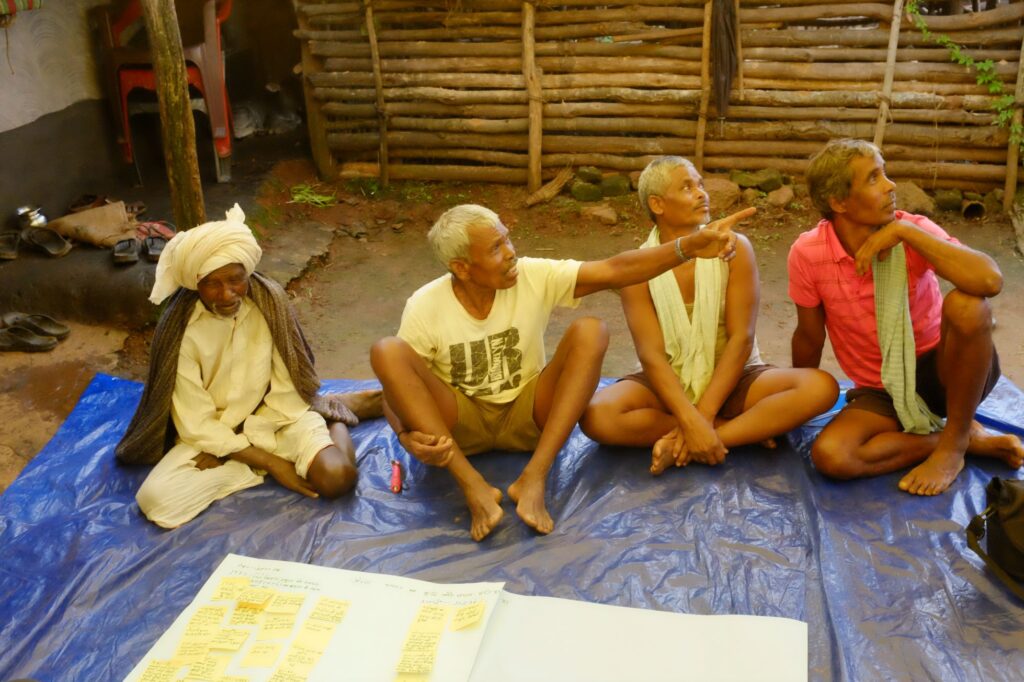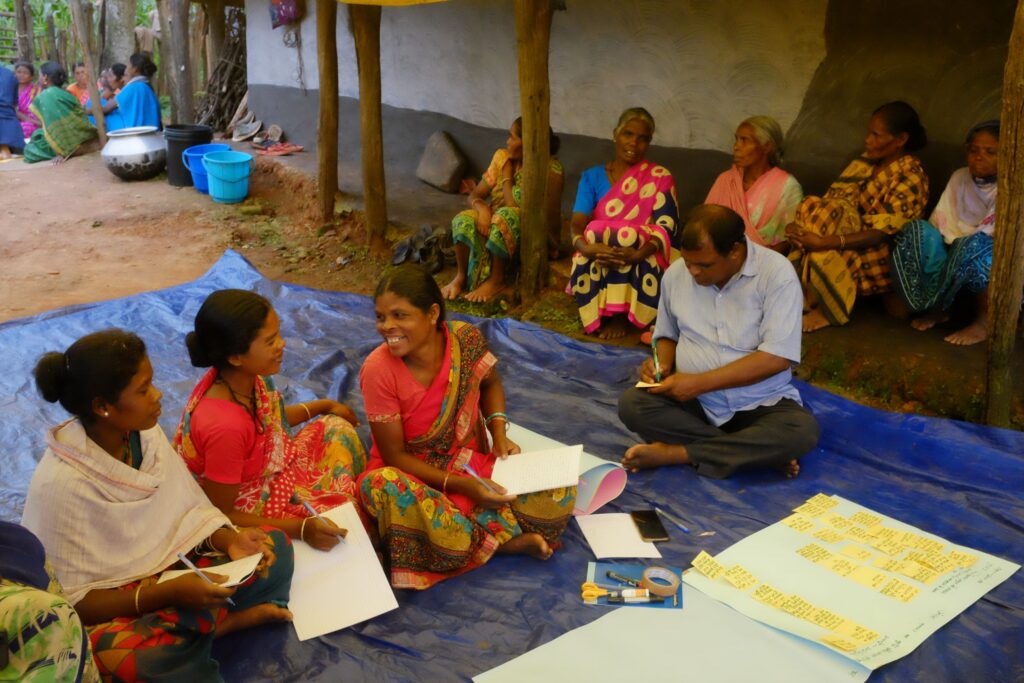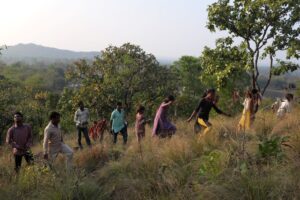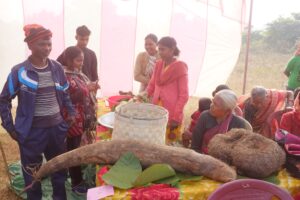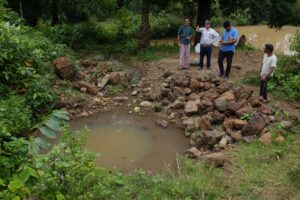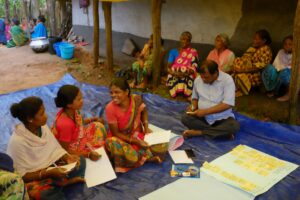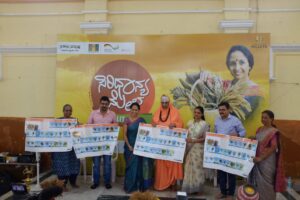On 13th September 2023 a Historical Timeline exercise for Orsa Panchayat, Mahuadanr Block, Latehar District, Jharkhand, with a focus on Agriculture, Food Systems and Forests was conducted in Chiro Nawa Toli. The exercise was conducted by Cordula Kujur and Rohan Mukerjee with Gram Pradhan and respected Community leader Narendra Nagesia carrying out community facilitation. In addition to Narendra the participants included 9 women and 6 men – Thamki Devi, Vihani Devi, Jahki Devi, Abha Nagesia, Budhni Nagesia, Phulkumari Nagesia, Khamsi Nagesia, Hirmania Nagesia, Narendra, Nagesia, Bandhan Nagesia, Virendra Nagesia, Devdhari Nagesia, Sikendra Nagesia and Nimla Nagesia. Note taking was carried out by 3 women participants – Aabha Nagesia, Amari Nagesia and Budhni Nagesia.
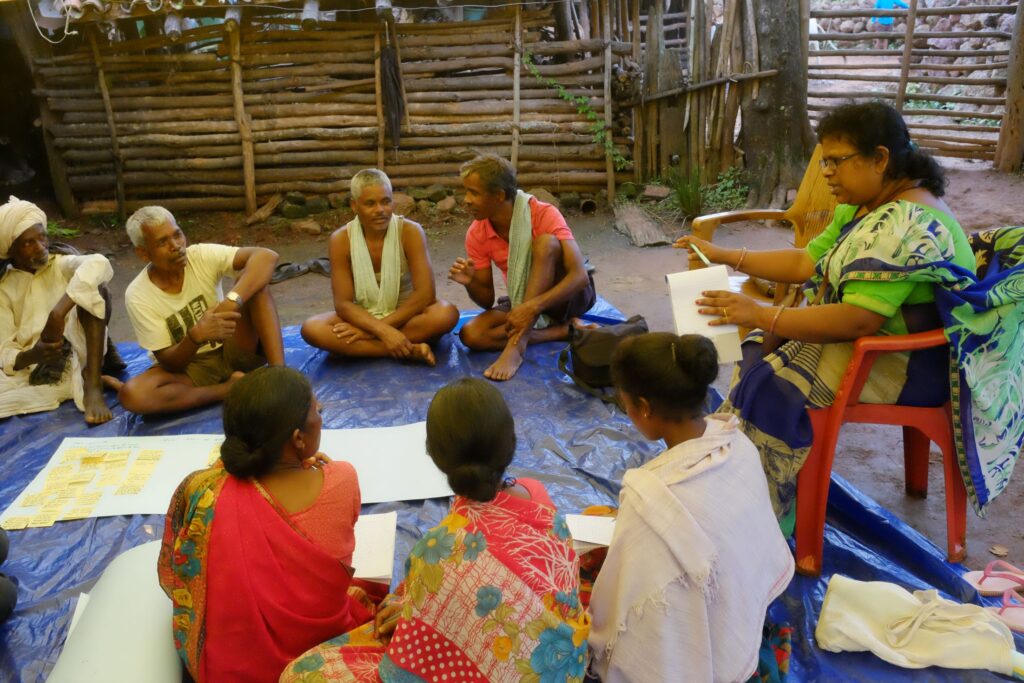
The Historical timeline exercise focused on explore prevailing conditions with regards to agricultural practices, food systems, forests and climate in the past, changes that occurred over time and current status. In order to explore prevailing conditions in the past they identified a significant event in the early 1980’s namely the establishment of Chiro Mission School in 1982 which was initially constructed using Dangai (Sorghum) stalks. This helped kickstart the timeline exercise enabling participants to recollect and share details of prevailing conditions in the 1980s. A significant event concerning Agriculture during the 1980’s identified by the participants was the fact that the Makka (Maize) crop failed in 1986 resulting in food scarcity. This was not a result of drought conditions but due to excessive rainfall for 2 years. The elders present shared that at the time they had to depend increasingly on food items prepared using uncultivated and wild foods like Mahua, Sarai / Sal, Genthi Kanda, Nakwa Kanda and Pitharu Kanda.
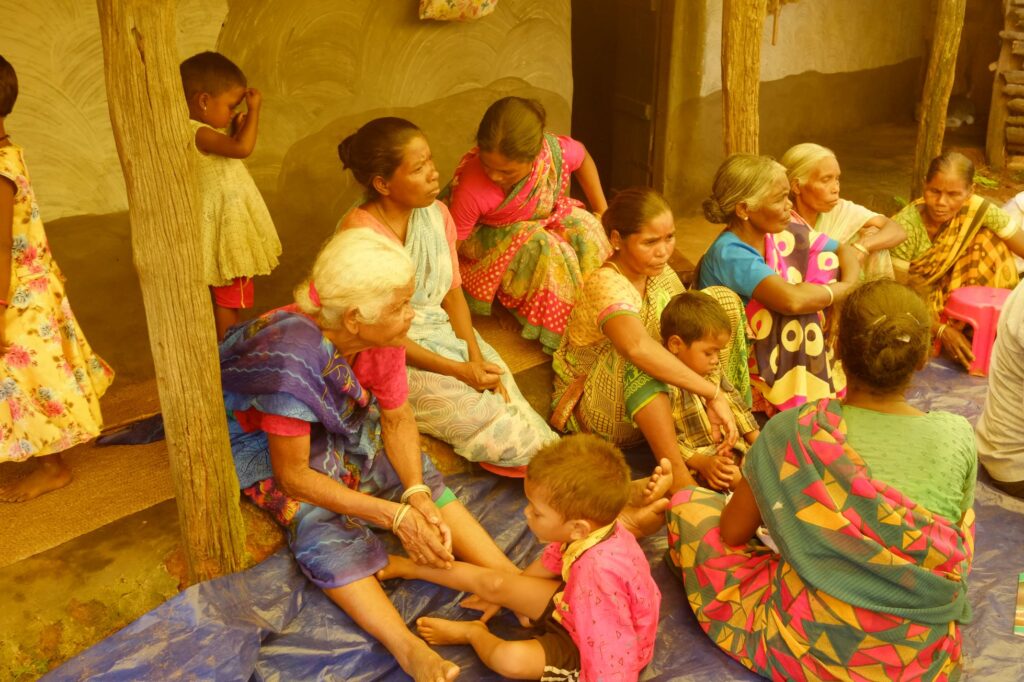
They shared that in the 1980s they used to cultivate a variety of different grains that included –
- Local and Traditional paddy varieties –
Goda Dhan (Upland Paddy)
- Karanga Goda
- Dani Goda
- Chain Goda
- Malchi Goda
Dhan (Dain) –
- Jenjene Dhan
- Karhaini Dhan
- Ramdi Dhan
- Rani Kajar
- Kalamdani
- Chandan Phul
- Baans Phul
- Siki Dhan
- Harra Khuta Dhan
- Bhainsa Javair
- Lal Dhan
- Bidi Khavas Dhan
- Makkai (Maize) –
- Safed
- Lal
- Peela
- Kala
- Gundli (little Millet)
- Charki
- Sarale
- Buda / Kala
- Dangai / Bajra (Sorghum) – 2 varieties (confirm)
- Madua (Finger Millet) – Dhela Madua and Gojra Madua
- Kodo
- Sanwa (Barnyard Millet)
- Bede (Need to check if it is a kind of little millet)
- Tangun (Foxtail millet)
- Sikri / Sikta (Crabgrass / Sikiya)
- Daal (Pulses) –
- Arhar / Rahair
- Ram Kurthi / Bhates
- Dal Kurthi
- Masri Daal
- Tusru Daal
- Bodi Daal
- Urad / Uraid (Lanjara)
- Sabji (Vegetables)
- Bodi
- Badi Bodi (Barbatti)
- Dang Bodi
- Bewara Bodi
- Sembi – 4 varieties
- Tubers – Sakhin Kanda, Aar Kanda, Ratna Kanda, Pechki Kanda, Sakar Kanda, Dang Danda
- Kaddu
- Kohda
- Jhinga
- Gongra
- Koita (like Nenua)
- Badi Bhata
- Aloo Lal
- Khera
- Bhindi
- Oilseed – Sarso, Kala Peela Lotni, Tisi (Alsi), Jatangi / Sarguja / Gunga (Niger)
The participants shared that there were no hybrid varieties or external varieties during the 1980s. The farmers exchanged seeds with each other using barter system (exchange one seed for another variety) and they never used money to purchase seeds.
The commercial crops were Safed Makai (White Maize), Jatangi (Niger) and Sarso (Mustard). All the other crops were bartered for self-consumption. The participants recalled that they used to sell Safed Makka at the rate of 12 anna to 18 anna per Kilo. They used to sell their produce in Mahuadanr market and did not go to Samri at that time. There were no proper roads or transportation at the time, and they used to carry upto 40 kg headloads from their villages to Mahuadanr market. Lal Aloo was cultivated at that time but only for self-consumption.
Soil quality – During the 1980s they followed the practice of Parti – fallow, with fields being left fallow for one year for grazing of livestock with provided the land with manure adding to soil fertility.
Average crop yields:
| Sr. No. | Crop | Quantity of Seeds sown | Yield (Quintal per Acre) |
| 1 | Gundli (Little Millet) | 20 kg | 6-7 |
| 2 | Makkai (Maize) | 3 kg | 10-12 |
| 3 | Goda Dhan (Upland Paddy) | 18-20 kg | 6-7 |
Rainfall – During the 1980s rainfall commenced in Baisakh (April 21 to May 21) and continued till Kunwar (September 23 to October 22) – Kartik (October 23 to November 21). Often they used to get excess rainfall which was bad for crops like Maize and this could have been one of the reasons behind the failure of Maize in 1986 when they said they had had 2 successive years of excessive rainfall. In Mang (January 21 to February 19) they used to get some rainfall know as Madheda which enabled them to visit forest areas to extract the wild tuber – Pitharu Kanda.
Inputs – They used to use only manure and no chemical fertilizers. Pesticides comprised – Kachha Gobar and Karil (Bamboo shoot) ka pani, Saale (a tree whose wood is used to make matchsticks) pati, Dori ka khalli (skin of Mahua fruits) and Raak (Ash).
Irrigation – a majority of the households had no irrigation facilities with only a few households diverting stream water to their fields.
Ploughing was carried out using Bail (Bullocks) and their were no tractors at that time. Narendra shared a phrase to describe the ploughing process “Loha ka Phar aur Lakdi ka Haar”
Loans were taken from moneylenders in adjoining villages at different rates –
1.25 – Sawaiya
1.5 – Deria
2.5 – Baoi (Confirm)
3 – Beeja
Land leasing arrangements –
- Adh Batai – Share cropping
- Rahan Bandhak – arrangement for fixed amount within the village itself.
Community institutions – During the 1980s there were no SHGs. The Pat Agargami Sangh was formed and became active from 1984 onwards to oppose Bauxite mining in the area.
Schemes (1980-82) –
- Bulgur– They used to get Genhu Dalia, Tel in exchange for digging work in their fields – Khet Samtalikaran to prevent soil erosion. The different produce which they received was from America, Narendra remembers references to America on the packaging. Later they even received Maize (Hybrid), Genhu (Wheat) and Bajra.
- Medh Bandhi Aur Aadi ko uuncha banana –This was a government scheme for improvement of agricultural lands. The contracts for this work used to be taken up by contractors but villagers reported that corruption was less and work got done. The rate was Rs. 5 per Chowka.
Water Sources –
The villagers used to access several streams and springs which were perennial sources of water for drinking, bathing and other uses. The participants counted around 20 perennial streams that were active in Orsa Panchayat at that time.
Forests – Participants reported that the forests were more dense at that time with an abundance of forest produce and wild food like Harra, Behara, Chironji, Amla, Bel and Aam.
Changes in Agriculture and Food Systems
In 2005-06 Hybrid seeds first entered the area through the Mahajan (Middleman). The first Hybrid seeds were for Maize, Potato and Tao (Buckwheat). The villagers feel that the promotion of Hybrid seeds and associated chemical intensive agriculture was a conspiracy hatched by the owners of the Bauxite mining company. They felt that since they had not agreed to give their lands for Bauxite mining the Bauxite mining company in collusion with Mahajans decided to make their lands infertile through the introduction of Hybrid seeds and chemical farming. Farmers of the area used to plough their fields one year in advance for cultivation of Gundli (Little Millet) in the next year. The middlemen used this as an entry point telling the farmers that they would take their lands on lease for the cultivation of Aloo and Tao which would help prepare the land for Gundli cultivation in the next year. Potato and Tao were short duration crops taking only 2-3 months each enabling both crops to be harvested on a single plot in a year after which the land was left for Gundli cultivation in the next year. The Mahajan took the lands on rent at rates of around Rs. 2000 per acre and alcohol. This was quite an exploitative arrangement. Initially only farmers in Orsa entered into land leasing arrangements with Mahajans but after around 10 years in 2016 farmers in Orsa also started entering into such arrangements. Currently they feel around 50% of households in Orsa Panchayat enter into such land leasing arrangements with Mahajans.
After the introduction of Hybrid Maize, Potato and Buckwheat hybrid varieties of other crops started entering Orsa Panchayat. These included Dhan / Paddy, and vegetables seeds with participants sharing that even hybrid Sim has come. They even shared that one outside variety of Gundli /Little Millet has also entered their area.
Decline of Local Seed Varieties –
After the entry of Hybrid seeds, seeds of several local crop varieties have declined with some completely disappearing from the area. Crops that have disappeared include – Sanwa, Bede (check if this is a variety of little millet), Kodo, Tangun / Foxtail millet (This has been reintroduced through the EI project in 2023) and Sikri (Sikiya / Crabgrass); Koita ( like Nenua), Stapati Jhinga (Clustered Jhinga); Kala / Kaawa Makka.
Availability of several seeds and crops has declined like – Dangai, Chota Gundli, Dhela Madua, (note Gojra Madua is still there), Lal Dhan, Chandan Phul, Baans Phul, Karhaini (they got Karhaini through the EI project in 2023), Jenjene, Gongra, some varieties of Kadu, Tumla; Mitha Geth Kanda.
Current source of seeds – Seeds are currently bout from Beej Bhandar and some seeds like Makkai and Dhan (Hybrid varieties) are received from the government at subsidized prices. In the Pat they often don’t get to hear about a lot of Agriculture schemes and policies and so often cannot avail themselves of such schemes.
Fertilizers and Pesticides – In 1996 farmers first started using chemical fertilizers for Goda Dhan and Makkai. With the switch to Hybrid seeds the usage of fertilizers increased with fertilizers in use being Urea, DAP and Rakhar (SSP). Currently the mix all these three fertilizers and use them in their fields.
Form 2010 onwards the usage if Insecticide and herbicide began. The principal pest was Gandi insect.
Mechanization – The use of tractors for ploughing commenced in 2006 currently around 50% of farmers make use of tractors to do fast ploughing. But they all agreed that ploughing with Bullocks is better. They feel that the tractor ploughs too deep – 5 inches while the Bullock only ploughs 3 inches which is ideal. With tractor ploughing the fertile soil gets turned over and covered (need to clarify).
Irrigation – same as before with no irrigation facilities provided for farmers. Around 30 years ago an effort was made to establish Lift irrigation from Buda Nadi and infrastructure was set up and water was even pumped once to the farmers’ fields. But after that it was never pumped again and subsequently the pipes were stolen.
Rainfall and Climate – Rainfall reduced and became more erratic with a shorter monsoon season from 1990 onwards. The situation worsened after 2012-13. Heat has also increased considerably and they reported that they never encountered Loo when they went hunting in the afternoon in summer months but this is no longer the case. 2022-23 has been a particularly bad year with the area witnessing Drought like conditions.
Water sources – Currently even after the first rains water level in springs and holes does not increase. In 2023 several streams are not flowing even in September. Currently springs and streams are no longer perennial. The villagers referred to a water source called Amtha Chua whose water tasted sour, but this taste has reduced. A test of this water source by Soumik Banerjee revealed that the water is acidic.
They reported that in Buda Nadi majority of small fish have died due to increased usage of pesticides which drain into the river. They stated that the fish was more tasty in the past.
Community Institutions – After 2000 several women’s SHGs were formed. But currently they are on the verge of breaking up due to issues with the Banks. Banks lacked transparency in their dealings with SHGs and often enrolled them for schemes and policies with proper explanations and this lack of communication has also led to mismanagement of loans. Participants felt that the bank often cuts money from their accounts without proper reason.
Schemes – while there has been an increase in different kinds of schemes there is also corruption in implementation of all schemes with the Dalal / Thekedar (Middleman) taking their cut even in MGNREGA.
Forests – They felt that the quality of forests has declined with the number of trees diminishing. Availability of wild food and NTFPs has also decreased.
Health – while Malaria has reduced other illnesses and health problems have increased. The participants shared that the occurrence of Dard (Pain) has increased and so have conditions and illnesses like – Lakua (Paralysis), Piliya (Jaundice), Migi (Epilepsy), Diabetes, High Blood Pressure and Pneumonia.
One on one interview with village elder Bandhan Nagesia from Orsa Ambakona and women on Bewara –
The Nagesia people have carried out a shifting cultivation practice referred to as Bewara on hill slopes. Bandhan shared that they cleared Sarai / Sal trees for shifting cultivation but with increasing restrictions from the Forest Department the practice has been restricted to private lands covered with Lantana. They now clear lantana and cultivate crops like Tusru (Rice bean), Rahar (Pigeon pea), Kurthi (horse gram) and Maize.
In the past they cultivated a greater diversity of crops which included – Makka, Tangun (Foxtail millet), Bede (a variety of little millet?), Dhela Madua (Finger Millet), Tusru (Rice bean), Raher (Pigeon pea), Urid / Urad (Black gram split), Kurthi varieties like Jaith Kurthi (Horsegram). They planted Papaya along the borders to serve as fencing. They also cultivated a variety of vegetables like – Kohonda, Jhinga, Khira, Simbi, Karela, Bhindi and Kadu.
Some challenges faced with Bewara were as follows –
- Strong winds posed a challenge to Bewara crops.
- Labour intensive nature was a challenge.
Gradually they moved away from Bewara and focused increasingly on cultivation in Tand areas (Plateau) where they carry out monocropping. Mixed cropping is currently mostly limited to Badi / homestead plots. The number of families still carrying out Bewara has declined considerably and only a few households still follow this practice. But efforts are being made to revive crop diversity in Bewara and this year through the EI project Tangun has been reintroduced and rahar seeds have also been provided. Currently fallow period is 1-2 years but we could not ascertain fallow period in the past when large trees were felled.
